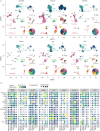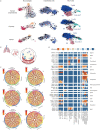A pulmonologist's guide to perform and analyse cross-species single lung cell transcriptomics
- PMID: 35896273
- PMCID: PMC9724811
- DOI: 10.1183/16000617.0056-2022
A pulmonologist's guide to perform and analyse cross-species single lung cell transcriptomics
Abstract
Single-cell ribonucleic acid sequencing is becoming widely employed to study biological processes at a novel resolution depth. The ability to analyse transcriptomes of multiple heterogeneous cell types in parallel is especially valuable for cell-focused lung research where a variety of resident and recruited cells are essential for maintaining organ functionality. We compared the single-cell transcriptomes from publicly available and unpublished datasets of the lungs in six different species: human (Homo sapiens), African green monkey (Chlorocebus sabaeus), pig (Sus domesticus), hamster (Mesocricetus auratus), rat (Rattus norvegicus) and mouse (Mus musculus) by employing RNA velocity and intercellular communication based on ligand-receptor co-expression, among other techniques. Specifically, we demonstrated a workflow for interspecies data integration, applied a single unified gene nomenclature, performed cell-specific clustering and identified marker genes for each species. Overall, integrative approaches combining newly sequenced as well as publicly available datasets could help identify species-specific transcriptomic signatures in both healthy and diseased lung tissue and select appropriate models for future respiratory research.
Copyright ©The authors 2022.
Conflict of interest statement
Conflict of interest: H. Kirsten reports support for the present manuscript from German Federal Ministry of Education and Research (BMBF) grants e:Med CAPSyS (01ZX1304A) and e:Med SYMPATH (01ZX1906B). E. Wyler has received payment or honoraria for lectures, presentations, speakers’ bureaus, manuscript writing or educational events from Podcast Gegenblende by DGB, outside the submitted work. M. Landthaler reports support for the present manuscript from Berlin Institute of Health. M. Scholz has received grants or contracts from Pfizer Inc. for a project not related to this research. W.M. Kuebler reports support for the present manuscript from German Research Foundation (KU 1218/9-1, KU 1218/11-1, CRC TR84 A02, CRC TR84 C09, CRC 1449 B01), Germany Ministry for Research and Education (SYMPATH, PROVID consortia), German Center for Cardiovascular Research (Partner site project Berlin) and Berlin Institute of Health (Focus Area Vascular Biology). M. Witzenrath has received grants or contracts from Deutsche Forschungsgemeinschaft, Bundesministerium für Bildung und Forschung, Deutsche Gesellschaft für Pneumologie, European Respiratory Society, Marie Curie Foundation, Else Kröner Fresenius Stiftung, Capnetz Stiftung, International Max Planck Research School, Quark Pharma, Takeda Pharma, Noxxon, Pantherna, Silence Therapeutics, Vaxxilon, Actelion, Bayer Health Care, Biotest and Boehringer Ingelheim, outside the submitted work. M. Witzenrath has received personal fees for consulting from Noxxon, Pantherna, Silence Therapeutics, Vaxxilon, Aptarion, GlaxoSmithKline, Sinoxa and Biotest, and for lectures, presentations, speakers’ bureaus, manuscript writing or educational events from AstraZeneca, Berlin Chemie, Chiesi, Novartis, Teva, Actelion, Boehringer Ingelheim, GlaxoSmithKline, Biotest and Bayer Health Care, outside the submitted work. M. Witzenrath has the following patents planned, issued or pending: EPO 12181535.1: IL-27 for modulation of immune response in acute lung injury (issued: 2012); WO/2010/094491: Means for inhibiting the expression of Ang-2 (issued: 2010); and DE 102020116249.9: Camostat/Niclosamide cotreatment in SARS-CoV-2 infected human lung cells (issued: 2020/21). G. Nouailles receives funding from Biotest AG for a project not related to this work. All other authors have nothing to disclose.
Figures



References
Publication types
MeSH terms
LinkOut - more resources
Full Text Sources
